On a crisp March evening in the spring of 2016, Kat Cannell and Missy Lipton unsaddled their ponies as inclement weather surrounded them and snowfall threatened. Soon after, on the first night of their 620-mile horseback ride from Hailey, Idaho, to Sierraville, California, snow began to swirl around their campfire, hissing as flakes met flame. It was a tempestuous backdrop to an expedition that had taken months to organize.
Similarly, Cannell’s mind was unsettled and storming. The logistics of this adventure were significant. There was much that could go wrong, and there was real risk involved. Travel through the Idaho, Oregon, Nevada and California backroads was a serious undertaking, especially for a 25-year-old woman who harbored fears of the dark, camping alone, wild animals, and the unknown in general.
But there was far more that was troubling her on that blustery night. Cannell, a recent rehabilitation outpatient for a powerful eating disorder, dealt every day with the often-paralyzing effects of body dysmorphia, a condition that results in the belief that one is being negatively judged by others for an unappealing physical appearance. And those insecurities and fears were rising up inside her on that dark Idaho night.
Lipton, on the other hand, was upbeat and excited. She was optimistic about their journey and what adventure might lie ahead. Ironically, 24 hours later, Lipton entered the emergency room with a badly shattered collarbone, the result of being bucked violently onto rough ground. For Lipton, the journey was over nearly before it began. She was devastated.
Cannell was now forced to make a difficult decision. Should she continue on or hang up her chaps? Was this a bad omen signaling a really bad idea or was this karma waiting to be revealed? After two days mulling over her next move, Cannell decided to push forward, her internal fears and doubts clawing at her all the way to her departure.
Alone.
So how did the idea of such a substantive and challenging adventure originate for the Stanley, Idaho, native? Surprisingly, the story began 3,600 miles and one continent away in the azure skies of South American Colombia.
“Willi, my husband, and I were in Colombia. Willi’s paragliding buddy offered to take me on a tandem paraglide ride. I was airsick the whole time, throwing up in my mouth. And I was totally blown away and moved,” Cannell said with a mixed tone of nostalgia and awe. “I thought it would be so cool to cover all of the country we saw from the sky on horseback. I wanted to be the best I could possibly be and push it as hard as I could possibly push it. Riding long distances is a great way to see the country.”
And long horseback rides have also served the purpose of allowing Cannell to address her inner demons. “I went to rehab for an eating disorder. I beat that. But I remember looking in the mirror one day and crying,” Cannell shared. “I got to the point where I was really fed up. I thought that if a 600-mile ride couldn’t get me away from those feelings, nothing could.”
However, it was one thing to conceptualize a 620-mile horseback ride. It was another to plan and execute the logistics for such a monumental effort. Fortunately, Kat had recently married Willi Cannell, who runs his outfitting business, Solitude River Trips, near their home in Stanley.
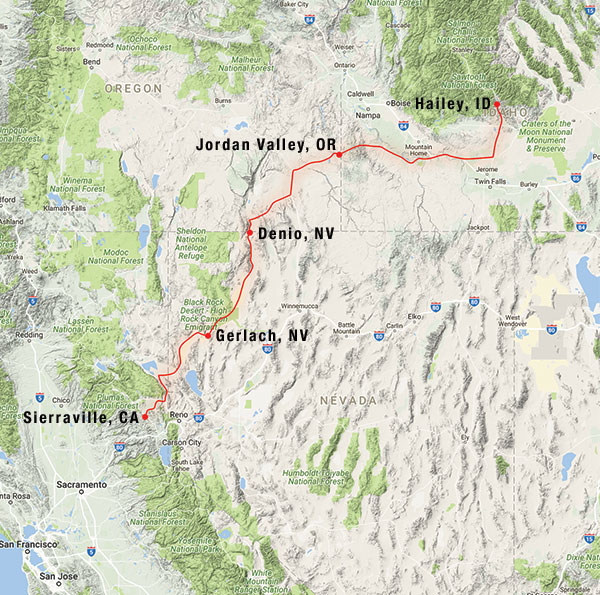
Cannell’s journey took her along highways, byways, and dirt roads. Much of the terrain was rugged, including sections through the Black Rock Desert and the 19th century Idaho, Oregon, Nevada (ION) Immigrant Trail.
“I tapped into Willi’s outfitter mind. I outfitted myself as if I was going on a backpacking trip: a water filter, stove, dehydrated food, and beef jerky. I packed that sort of stuff,” Cannell said. “I planned to be highly self-sufficient. Ultimately, I had water, hay and grain support from Willi and my dad.”
“At no point was I nervous or hesitant about her trip. My only fears were that it might not happen,” the strawberry-bearded Willi Cannell said, admiring his wife from across the room. “That maybe, in the planning stages, she would view it as an impossible task or unreasonable plan. A lot of people said she should not do it, that it was not a good idea. I was encouraging from the beginning.”
Cannell’s father, Ken Smith, was also supportive of Kat’s plan and was a major contributing factor to her upbringing as a horsewoman. “It all started with Western movies: Gene Autry, the Lone Ranger, the Cisco Kid,” Smith related from his Sawtooth Valley home. “I was inspired to become a horseman because they always had wide open spaces and did not live in a city. I got to know horse people, which is a real good culture of people. They take care of animals, so they are fundamentally a good group of people.”
Once Cannell had committed to the ride, she began to identify her route and final destination. The route changed several times between her initial plan and its completion, including re-routing while on the trail. This was out of Cannell’s comfort zone as she is an extremely organized logistician. But it gave her the opportunity for personal growth.
“She realized that you have to let things flow,” her father added, “to be less focused on organizing and to deal with things that let you down. She was forced to be resilient and tenacious.”
Ultimately, she wound along the highways, byways, dirt roads and immigrant trails of the Rocky Mountain West, often leading her through rough and rugged terrain like the Black Rock Desert and along the ION highway (the Idaho, Oregon, Nevada immigrant trail used in the 19th century by pioneers).
Along the way she met some amazing individuals, including cowboys, cattlemen, backcountry travellers and an 80-year-old female ranch owner who used to be a stuntwoman horseback rider in John Wayne movies.
One of her most striking memories included encountering Native American “hoodoos.” These human-shaped rock piles were constructed hundreds of years ago to scare deer and antelope up specific gullies where the hunters would wait in ambush. She also stumbled upon a Burning Man (an annual gathering in the Black Rock Desert of Nevada) storage area that hid hundreds of decorated “art cars” and thousands of bicycles covered in fur.
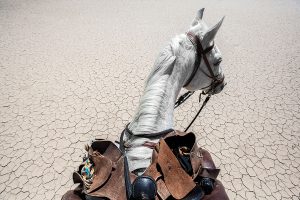
Crossing a playa west of the Black Rock Desert
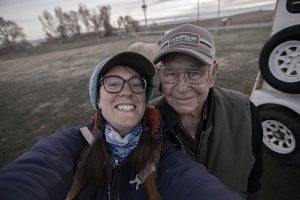
with 86-year-old Burrel Williams, who let Cannell camp in his pasture
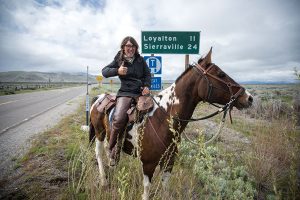
just before ascending the Owyhee Mountains
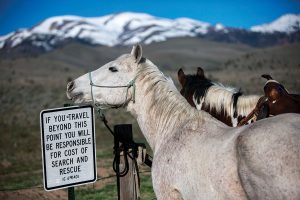
the home stretch into Sierraville
Perhaps her most powerful memory was generated while galloping through the Nevada desert. While riding Pony Express-style through sage and bitterbrush, her horse turned his head suddenly to the right. Cannell traced his line of sight to find a herd of wild horses galloping parallel to their path in sync. It was a visual she will never forget.
After a month in the saddle, Cannell finally rode into Sierraville, California, the terminus of her adventure. On her final night in camp, Willi joined her. He was impressed with the growth in her skill levels as a horsewoman, camper and self-sufficient traveller. And, as on the first night of the journey, snow fell upon their camp.
When asked if she achieved her goals of completing such an enormous personal challenge while directly facing her many fears of isolation and personal doubt, Cannell nodded her head in confirmation.
“I achieved the goals I wanted to achieve, but in different ways than I expected. I still look how I look, I still am who I am, but I have achieved a new identity. It gave me a new confidence that I didn’t have before,” Cannell said. “I am a river guide who rows big badass boats, but I’m a horsewoman, too. When I get hard on myself about the way I look, now I can talk myself down more easily. It sounds vain but it is crippling. I felt like everyone was judging me constantly. But now I realize that if someone is judging me it is their problem not mine.”
“A lot of overcoming my challenges comes from reading books and stories about people overcoming theirs,” Cannell continued. “I hope that sharing my story will help people to do the same thing.”
